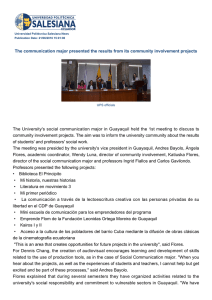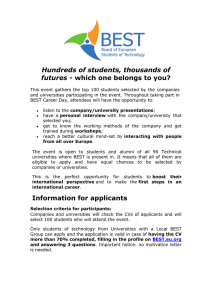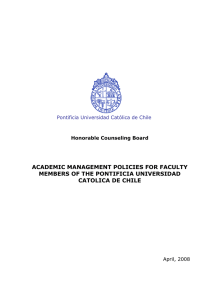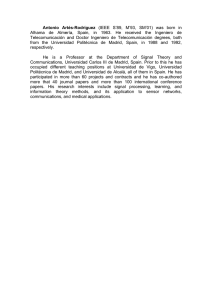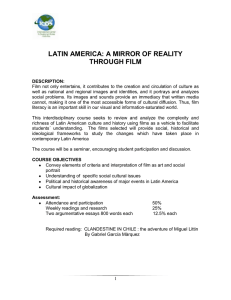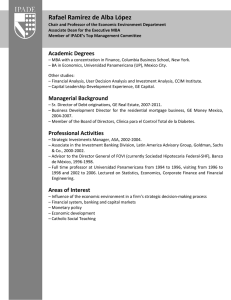Chapter 41. Section Essay: Who Takes Care of Writing in Latin
Anuncio
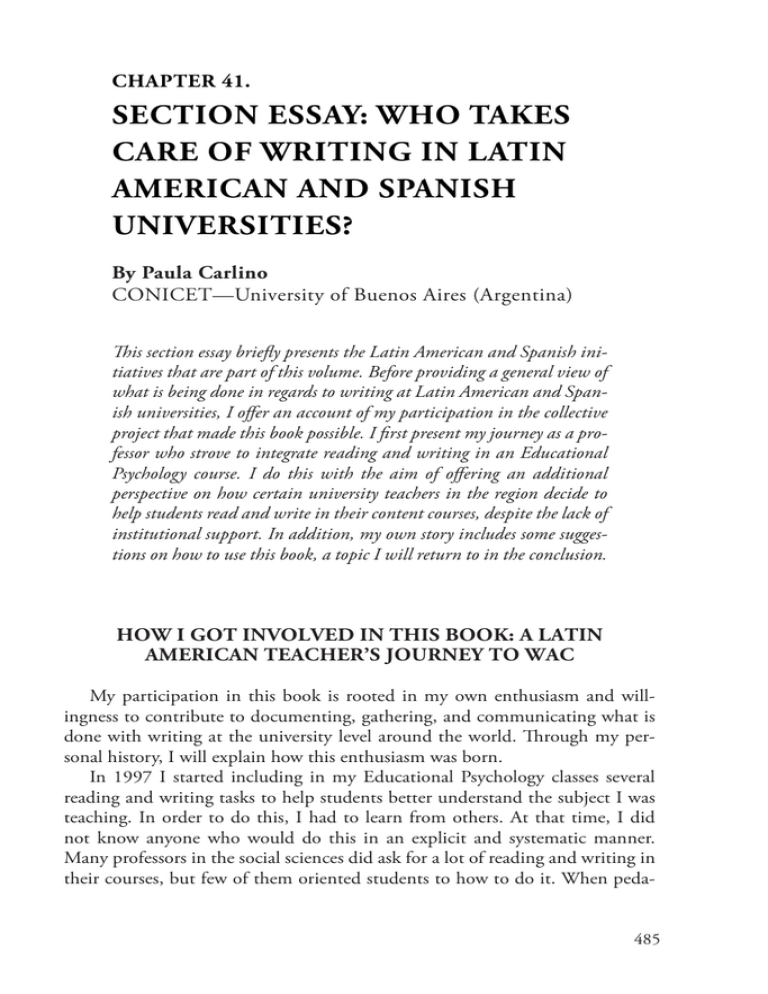
CHAPTER 41. SECTION ESSAY: WHO TAKES CARE OF WRITING IN LATIN AMERICAN AND SPANISH UNIVERSITIES? By Paula Carlino CONICET—University of Buenos Aires (Argentina) This section essay briefly presents the Latin American and Spanish initiatives that are part of this volume. Before providing a general view of what is being done in regards to writing at Latin American and Spanish universities, I offer an account of my participation in the collective project that made this book possible. I first present my journey as a professor who strove to integrate reading and writing in an Educational Psychology course. I do this with the aim of offering an additional perspective on how certain university teachers in the region decide to help students read and write in their content courses, despite the lack of institutional support. In addition, my own story includes some suggestions on how to use this book, a topic I will return to in the conclusion. HOW I GOT INVOLVED IN THIS BOOK: A LATIN AMERICAN TEACHER’S JOURNEY TO WAC My participation in this book is rooted in my own enthusiasm and willingness to contribute to documenting, gathering, and communicating what is done with writing at the university level around the world. Through my personal history, I will explain how this enthusiasm was born. In 1997 I started including in my Educational Psychology classes several reading and writing tasks to help students better understand the subject I was teaching. In order to do this, I had to learn from others. At that time, I did not know anyone who would do this in an explicit and systematic manner. Many professors in the social sciences did ask for a lot of reading and writing in their courses, but few of them oriented students to how to do it. When peda485 Carlino gogical assistance was provided, it tended to be sporadic and insufficient. I had never heard of the Writing Across the Curriculum (WAC) or Writing in the Disciplines (WID) movements. The universe of ideas proposed by WAC/WID authors was simply out of my reach, since during my undergraduate studies in Argentina or my graduate studies in Spain I never came across these readings. However, my Psychology of Learning background had shown me that nobody learns just by receiving information in a passive way. Nobody learns by being a mere receiver of a given body of knowledge. Knowledge, in research and in learning, is not there to be taken. Instead, it needs to be created and recreated: the researcher creates knowledge and the students create their knowledge. None of them, researcher or student, receives knowledge that has been preformed. This is the epistemological essence of constructivism (Castorina, 2001; Ferreiro, 1999; Piaget & García, 1982). According to this principle, it did not make sense to organize my classes around lectures only. I had to plan class activities and assignments that would get undergraduates to participate at both cognitive and social levels. I wanted to do so not as an extension of my teaching but as a core activity. I would help them work throughout the semester and not only during the week of the exam. My graduate work on literacy was of great assistance to me in this task. The socio-cognitive activities that would lead students to learn the subject involved reading, writing, and exchanging ideas about the course concepts. Under certain conditions, reading and writing can prompt an intense cognitive activity (Bazerman et al., 2005; Langer & Applebee, 1987; Scardamalia & Bereiter, 1985; Wells, 1987) and I was attempting to recreate these conditions. But I would not just require those tasks without offering further guidance. I knew students needed to be oriented and receive feedback, since they were newcomers to the field and therefore would be somewhat lost without this support. I had often heard professors complain, “Students don’t know how to write. They don’t understand what they read—they don’t read.” Instead, I was convinced that many students did not do what teachers were expecting of them because they did not know how. As a result, I decided to organize activities in a way that would allow students to participate. Thus, I guided students and provided feedback while they completed such activities as discussing readings, making connections among texts, and reviewing what they had written (Dysthe, 1996): all this, with the aim of helping them gradually understand the ideas of the course. By reading and writing about the subject, they could recreate the knowledge for themselves, something that a teacher could not directly transmit to them. In brief, these literate activities were integrated into the course to help students understand and study its contents. Along the way, however, I discovered 486 Who Takes Care of Writing in Latin American and Spanish Universities? that these activities also contributed to another equally relevant purpose: helping students acquire new ways of thinking, making an argument, debating, explaining, and writing on topics related to the field. I realized that supporting their participation in literate tasks had led me to inadvertently teach a new content: how to interpret and produce the discourse of the discipline I was teaching. QUESTIONS THAT A TEACHER ASKS HERSELF During this journey, I began to ask myself: How best could I approach these goals? What writing and reading assignments should I ask from the students, and what kinds of help should I provide? How much time should I allocate for these activities and how much should I spend lecturing? How would these tasks relate to the exams? And above all, who could I learn from? There were other questions as well: How much time would I devote to design and implement these activities? Would I be able to do this in a work context in which I was totally alone and lacking institutional support? With whom could I share my experiences and discuss them? I came up with two answers. On the one hand, I began an extensive Internet search in order to find out how professors from universities around the world were dealing with similar issues. I discovered the Australian Learning and Teaching Centres, the WAC programs in the United States, full text versions of conference papers, and countless websites where teaching practices were documented in detail. Entranced, I took on this task as a methodical exploration that lasted for two years. Whenever I found something relevant, I read it, and one website led to another. I selected, printed out, and organized materials, putting together a library of resources and a list of new links to continue exploring. As I went along, I decided what materials could help my teaching, and I modified them to try out in my classes. The response to my first set of questions was the following: I was going to learn to include work with reading and writing in my classes by testing variations of what other university professors had done, documented, and published on the Internet. On the other hand, the response to the second set of questions was to turn my teaching into a research activity as well (Hutchings & Shulman, 1999). I first planned to make my Internet searches systematic and to categorize my discoveries about what was being done in distant lands. This later became part of the theoretical framework of a six-year action research project in which I documented and critically examined my own teaching practice. In addition, I wrote about all of this, presented at conferences, and submitted papers for publishing. 487 Carlino Written “conversations” with my readers and with authors who had inspired me were very encouraging, since I did not have any close peers from whom I could learn and by whom I could feel supported. I did find this support from colleagues from different countries. Therefore, reading and publishing not only fueled my research but also my teaching. I decided to publish in Spanish, because it was difficult for me to write in English and because I hoped to spark dialogue in my own milieu. Looking back, this is how I would summarize my work for a period of six years (Carlino, 2005). This was my personal incentive for investing time and effort, though I expected to reap the benefits in terms of both my teaching and my potential contributions to the debates in the Writing Across the Curriculum field. WHAT THIS STORY TELLS ABOUT OTHER TEACHERS IN IBEROAMERICA I have shared my personal story because I believe it can help readers understand the context of teachers in many Spanish or Portuguese speaking countries. In these countries, professors face similar isolation in their academic contexts: limited institutional resources, scant activities for professional development, and a lack of knowledge of the epistemic power of writing and of WAC/WID programs in the English-speaking world. I believe that the questions mentioned in the previous section are critical to encourage content course professors to care for how their students read and write. These are questions that all institutions should address in order to implement cross-curricular writing initiatives. The first set of questions—“How best could I approach these goals? . . . who can I learn from?” —refers to how a professor whose first and foremost subject is not reading or writing can learn ways to develop and actually integrate these activities in the classroom. The second set of questions—“How much time would I devote to design and implement these activities? . . . With whom could I share my experiences and discuss them?” —is about how to sustain such activities over time if a professor is alone and has no support or institutional recognition. The following section describes profiles included in this book that show different initiatives that emerged from the personal conviction of their authors rather than from institutional policies—though some of them later gained university support. As a whole, the book explores both sets of questions and reveals that more than one path can be taken within different institutional contexts. When I found out about Chris Thaiss’ project, a project for researching, compiling, and disseminating the experiences of teaching writing and teaching 488 Who Takes Care of Writing in Latin American and Spanish Universities? with writing at universities across the world, I was thrilled. This book is part of the project, and I am sure it will be useful to many professors who not only want to integrate literacy work in their classes but also need to learn how to do so from others. In addition, I am convinced that the ideas brought here by each author will pave the way for institutions in our countries to understand that we will not get very far unless professors are accompanied in this challenge. “DO NOTHING,” “REMEDIAL,” OR INTEGRATED MODELS IN IBEROAMERICAN UNIVERSITIES In order to introduce the chapters on Latin America and the one on Spain, I will give an overview of what is happening in these places. According to the responses to the International WAC/WID Mapping Survey (see Thaiss essay in this volume) and the works presented at regional conferences, there is common concern about how university students read and write. This concern is what inspired the initiatives described in these chapters. Since the 1990s, different actions have been taken, some on the periphery and some more integrated. However, unlike what occurs in the US and Australia, Latin American and Spanish universities have fewer experiences and less institutional involvement for addressing questions concerning academic writing. If we considered the classification of initiatives proposed by Skillen, Merten, Trivett, and Percy (1998)—the “do nothing” model, the “remedial” model, and the integrated model—we would include what generally occurs in the region in the second model. However, there are some isolated initiatives that represent the integrated model; in some countries the “do nothing” model is still predominant. Regarding the “do nothing” model, Solé, Teberosky, and Castelló’s essay (this volume) explains why Spanish universities and teachers often neglect writing instruction. They generally hold the belief that “learning oral and written language occurs only in the first few years of compulsory education; this belief leads oral and written language to be treated as an ‘object’ of knowledge in these early stages. Thereafter, these capacities acquire the status of learning ‘instruments’ (and lose their former status).” It is also assumed that “oral and written language, as communication and (to a lesser extent) representation tools, remain invariable throughout a person’s life, while what varies are the situations in which these tools are ‘applied’” (Solé, Teberosky & Castelló, this volume). Similarly, in the “remedial” model, writing is seen as an autonomous code, ruled by universal conventions and with the normative level (spelling and grammar) appearing as its most visible attribute. Writing and reading, once dispos489 Carlino sessed of their social nature, are often conceived of as general abilities that can be transferred to any context, as noted by Russell (1990). It is believed that these skills can be taught and learned in ad hoc curricular spaces, dissociated from the spheres in which reading and writing are required for specific purposes. In such spaces, the contents related to reading and writing are generally presented through exercises that break down and transfigure the real literate practices in order to teach them divorced from their situated uses. For example, a recent survey done in Argentina (Carlino, Iglesia & Laxalt, 2010) found that 90% of 544 teachers across the higher education curriculum recognized that their students found it difficult to “read comprehensively and write clearly” in their courses. When asked what was done at the institutional level, 29% of the respondents stated that their institutions dealt with these problems and explained what was done. The most frequently mentioned initiatives were workshops and entry courses. Similarly, Fernandez Fastuca’s (2010) study showed that ad hoc initial courses greatly predominated over other institutional initiatives. Carlino et al.’s (2010) survey also explored whether professors did something about their students’ literacy problems, with 28% of the faculty declaring that they addressed reading and/or writing in content courses and describing what they did. Most commonly, professors’ interventions took place at the “margins” of the literate assignments, with professors requesting tasks, giving guidelines, teaching writing techniques at the beginning, and assessing students’ final products at the end. A smaller group of professors declared that they intervened during the writing process, devoting class time to literate tasks. Within this group, a reduced number of respondents explained that they promoted teacher-student interaction around disciplinary literacy. In other words, very few of the professors in the sample discussed readings with their students, commented on their drafts, or mentioned teacher feedback as well as peer interaction as part of their classes. These results confirm what was found in a previous qualitative inquiry with university students and teachers (Carlino, 2010). The author found that although literate assignments were very common in Social Science courses in Argentine universities, professors rarely offered support for how to do them: guidelines were rare and feedback minimal. In sum, those initiatives that address literacy in Argentine higher education institutions tend to take place outside the content areas and are dissociated from them. They are based on the idea that students can then transfer such learning to reading and writing in their disciplines. In addition, most professors in the disciplines require and assess students’ reading and writing, but very few of them consider these practices as an object of their instruction. When they intervene, they often do so at the periphery of the assignments. Although these findings come from Argentina, they are consistent with what is usually 490 Who Takes Care of Writing in Latin American and Spanish Universities? presented regarding other Spanish-speaking countries in regional conferences and journals. INITIATIVES IN IBEROAMERICA In the following paragraphs I review the Latin American and Spanish initiatives, some of which are included in this book. Writing Courses Writing courses are the most frequent initiatives developed by tertiary institutions (Carlino, Iglesia & Laxalt, 2010; Fernandez Fastuca, 2010). These courses vary in length and are usually confined to the first year of the programs (Gonzalez, this volume) or required as entry courses at the undergraduate level (e.g., Narvaja, Di Stefano & Pereira, 2002). In addition, some universities offer writing courses at the graduate level (Carlino, 2008, and in press; MottaRoth this volume; Solé, Teberosky & Castelló, this volume). Two theoretical viewpoints underpin writing courses: the remedial basic-skills approach and the genre-based developmental approach. In the remedial basic-skills approach, writing is taught as an autonomous object of study, “a single universally applicable skill, largely unrelated to ‘content,’ […] a separate and independent technique” (Russell, 1990, p. 55). As a result, students are expected to transfer this general writing skill to different disciplinary assignments. In the genre-based developmental approach, on the other hand, writing is not taught as a generic skill but in context. Based on a situated learning perspective, writing courses are designed to help in the production of texts in a particular discipline, for a specific audience. Therefore, students have several opportunities to draft, receive feedback, and redraft their texts (e.g., Carlino, in press; Motta-Roth, this volume). It is along these lines that Solé et al. (this volume) highlight the importance of the length of postgraduate seminars to allow for nurturing the learning processes involved in academic communication. Nevertheless, despite the fact that longer courses seem to be more encompassing, there is a potential problem associated with undergraduate or graduate programs offering writing courses: supporting student writing might fall only on the writing teacher’s shoulders. Therefore, professors teaching content courses might not be held responsible for helping students to develop their writing—and those teaching writing courses most probably will experience a sense of insufficiency and isolation (González, this volume). 491 Carlino Writing Centers The idea of a writing center with writing tutors is usually not known in Latin American or Spanish universities. Even the notion of receiving feedback, as a low-stakes reader’s response to a student-author’s text, is rare. Nevertheless, a handful of initiatives have appeared in recent years in countries such as Mexico (e.g., Galán Vélez & Ormsby, 2010) and Colombia (Molina, 2008). In addition, the history of the Puerto Rican writing center that García-Arroyo and Quintana offer in this volume exemplifies some of the difficulties that this type of initiative might face. Finally, most of the writing centers in Latin American and Spanish universities are based on the North American model and were preceded by local staff visiting several writing centers in the US. Writing centers, as an expression of the WAC movement, should reach the writing done in the disciplines. However, in our region they are still seen by many professors as a remedial service to fix students’ sentence-level problems. This is related to how writing is conceived. If writing is considered as a mere surface form dissociated from content, it is therefore confined to the writing center’s domain, with few content-course professors taking care of it (GarcíaArroyo & Quintana, this volume). Faculty Development Other initiatives in Latin America aim at raising awareness among contentcourse professors and instructors regarding the feasibility of dealing with students’ literacy in their own courses. To challenge commonsense assumptions, these initiatives discuss what literacy consists of, how reading and writing are learned, and why they may have an epistemic power, as well as whether they should be taught at the university level and across disciplines. At the same time, faculty development workshops show participants the most fruitful ways of assigning reading or writing and giving feedback to students. Thus, professors from various disciplines are helped to integrate literate assignments in their teaching with the aim of increasing students’ learning in a specific field. These experiences are worth noting since they try to make all the disciplines responsible for supporting student academic literacy instead of confining it in a separate curricular space (writing course) or service (writing center tutoring). However, since faculty development seminars are usually offered for only a few hours over a couple of months (e.g., Benvegnu, 2004; Marucco, 2004; Narvaez, this volume) and sometimes have an even shorter duration, professors are left on their own to put into practice what is theoretically discussed during the sessions. 492 Who Takes Care of Writing in Latin American and Spanish Universities? For example, Narváez (this volume) questions whether the length and format of these seminars can affect teachers’ instructional practices. The generally tight format in which most of the faculty development workshops are presented seems to be detrimental to this end. To overcome this limitation, Carlino & Martinez (2009) offered guidance as part of the process of changing cross-curricular instructional practices. Working with professors from various disciplines to help them integrate reading and writing in their classes, the authors approached the provision of faculty development as collective action-research for two years. Excepting some very short workshops, these initiatives do not originate from university-wide policies, but from the determination of individual academic developers. As a consequence, they are sporadic, discontinuous, and reach few faculty members. In contrast, the next paragraph describes a unique institutional program in the region that promotes faculty development that accompanies teachers for longer periods of time. Team Teaching The essay by Moyano and Natale (this volume) depicts a writing program that offers assistance to course-content faculty over an 18-month period to integrate the teaching of writing into their courses. To achieve this integrative goal, the program fosters interdisciplinary partnerships between writing instructors and class professors. They collaboratively construct an inventory of genres and skills necessary for the course and design how to teach them. The writing instructor participates in the class on selected occasions to analyze with students the required genres. Three or four times a semester, for a minimum of three semesters, the class professor and the writing instructor work together until the professor is able to do the job alone. This writing-across-the-curriculum program is a rare case in Latin America and Spain because it has gained clear institutional support to help students learn writing in context in all the subjects throughout the four years of study. It also contributes to faculty development through interdisciplinary collaboration. It is worth noting that this example of team teaching resembles the Australian IDEALL project (Purser, Skillen, Deane, Donohue & Peake, 2008; Skillen et al., 1998;). Both initiatives take into account the principles of the “systemic approach: the shift in focus from working outside the curriculum to one that addresses the issues inside the curriculum […] by collaborating with discipline staff; the importance of working at the faculty and department level to make these collaborations strategic; and the need to participate in and impact upon policy decisions” (Percy & Skillen, 2000). 493 Carlino Writing Instruction Interwoven in Disciplinary Courses Although faculty development actions are sporadic and limited, and teambased teaching is exceptional, there are some Iberoamerican professors who help develop student literacy in their content courses without any institutional support. Most of them have a Psychology, Education or Linguistics background. They draw on this knowledge to develop creative ways to enhance learning by offering guidance and feedback during the regular reading and writing tasks implemented in their classrooms (e.g., Carlino, 2005; Fernandez et al, 2004; Narváez, this volume; Padilla & Carlino, 2010; Vázquez & Jacob, 2007). They “interweave” literate activities through their courses and organize their classes to intervene during the processes of reading and writing. This concept contrasts with that of professors who only “sew” literate tasks on to their courses and intervene in a “peripheral” way, just requiring and assessing writing assignments. While in the “interwoven model” (Carlino, Iglesia & Laxalt, 2010) the professor helps students take part in the study practices she/he considers necessary to learn the subject, in the “sewed model” students are supposed to already have the necessary knowledge to do so on their own. The way professors in the disciplines include writing and reading in their classes—as integrated or intertwined activities or as added or sewed-on foreign elements—has clear consequences for the quality and equity of education. In the first case, the method nurtures the development of disciplinary literacy, while in the latter the method just demands it. De Micheli and Iglesia (this volume) provide an unusual illustration of the interwoven writing model in a Biology course. They not only assign microthemes, in which students have to make connections among disciplinary concepts, but usually devote class time to collectively plan or review students’ texts. They also give them quick written feedback, only assigning a grade in exams. In this way, students are given beforehand several opportunities to practice and receive feedback on the type of writing that later they will be required to do in the exams (for example, explaining practical situations through relating key concepts). Thus, they have the opportunity to study biology with the support of their teachers, who have also responded to their successive brief essays. Experiences like this promote faculty-student and peer interaction around disciplinary literacy, constituting an example of dialogic teaching strategies (Dysthe, 1996). In the interwoven model, written assignments help students learn disciplinary content and go beyond just being a means of assessment. Students receive teacher support during the process of reading and writing, which allows them to understand the subject and, at the same time, develop their literacy. Furthermore, intertwining literate tasks in the courses leads to 494 Who Takes Care of Writing in Latin American and Spanish Universities? avoiding teacher-centered classes and encourages students to take a more active role in the course. Finally, it is worth mentioning that since interwoven writing strategies are usually time-consuming, teachers who adopt this model often study their practices as part of their research commitment. Otherwise, it is very difficult for these faculty to sustain these teaching practices, especially with numerous students. CONCLUSION Latin American and Spanish universities have recently begun to address students’ academic literacy needs. The essays by De Micheli and Iglesia, García-Arroyo and Quintana, González, Motta-Roth, Moyano and Natale, Narváez, and Solé et al. in this volume illustrate some of the most relevant initiatives collected in their countries. The essays show both the strong commitment by their authors and the irregular support by their institutions. It is in this regard that these profiles, as well as the whole book, can inspire teachers and institutions to develop their own ways of addressing literacy across the curriculum. The variety of examples and details offered by the authors in these pages will aid readers in foreseeing some challenges and opportunities. These vicarious experiences could encourage readers to experiment within their circumstances without beginning from zero. Besides, the book can raise our awareness about what is being done or neglected in our own universities regarding students’ writing. The range of perspectives presented over these chapters will hopefully allow us to see with fresh eyes what is done or not in our own institutional settings and acknowledge that what is occurring is just an option among others, and not something natural or necessary. This contrast will help us denaturalize familiar practices and open them to critique. Furthermore, the collection of profiles in this volume will be useful toward our questioning the ways of doing (or not doing) established in our institutions and perhaps inspire our advocating for institutional changes to better support the development of students’ academic reading and writing. ACKNOWLEDGEMENTS I would like to thank Dr. Laura Colombo for generously helping me in editing the English version of this chapter. 495 Carlino REFERENCES Bazerman, C., Little, J., Bethel, L., Chavkin, T., Fouquette, D., & Garufis, J. (2005). Reference guide to writing across the curriculum. West Lafayette, Indiana, and Fort Collins, Colorado: Parlor Press and the WAC Clearinghouse. Retrieved from http://wac.colostate.edu/books/bazerman_wac/ Benvegnu, M.A. (2004). Las prácticas de lectura en la universidad: Un taller para docentes. In P. Carlino (Ed.), Leer y escribir en la universidad (pp. 4357). Colección Textos en Contexto nº 6. Buenos Aires: Lectura y Vida. Carlino, P. (2008). Exploración de géneros, diario de tesis y revisión entre pares: Análisis de un ciclo de investigación-acción en talleres de tesis de posgrado. In E. Narvaja de Arnoux (Comp.), Escritura y producción de conocimientos en carreras de posgrado. Buenos Aires: Santiago Arcos. Retrieved from https:// sites.google.com/site/jornadasgiceolem/posgrado Carlino, P. (2010). Reading and writing in the Social Sciences in Argentine universities. In C. Bazerman et al. (Eds.), Traditions of writing research (pp. 283-96). Oxford: Routledge. Carlino, P. (2012). Helping education doctoral students face writing and emotional challenges towards identity change. In M. Castelló & C. Donahue (Eds.), University writing: Selves and texts in academic societies. Sig-W Series Volume on Academic Writing. London: Emerald Group. Carlino, P. Iglesia, P., & Laxalt, I. (2010, September). Leer y escribir en la formación de profesores secundarios de diversas disciplinas: Qué dicen los docentes que se hace. Memorias de las Jornadas Nacionales “Lectura, escritura y aprendizaje disciplinar.” Facultad de Ciencias Humanas, Universidad Nacional de Río Cuarto, Córdoba, Argentina. Castorina, J. A. (2001). Las versiones del constructivismo ante el conocimiento instituido y las prácticas sociales. Contextos de Educación, 5, 17-40. Dysthe, O. (1996). The multivoiced classroom: Interactions of writing and classroom discourse. Written Communication, 13(3), 385-425. Fernández, G., Izuzquiza, M. V., & Laxalt, I. (2004). El docente universitario frente al desafío de enseñar a leer. In P. Carlino (Ed.), Leer y escribir en la universidad (pp. 97-110). Colección Textos en Contexto nº 6. Buenos Aires: Lectura y Vida. Fernández Fastuca, L. (2010). La enseñanza de la escritura académica en las universidades del área metropolitana de Buenos Aires. Unpublished master’s thesis, Buenos Aires, Universidad de San Andrés. Ferreiro, E. (1999). Cultura escrita y educación. México: Fondo de Cultura Económica. Galán Vélez, R., & Ormsby, L. (2010). El centro de escritura como puente en la educación superior: El Centro de Aprendizaje, Redacción y Lenguas 496 Who Takes Care of Writing in Latin American and Spanish Universities? del ITAM. En Guadalupe Ruiz Cuellar, Guadalupe López Bonilla & Alma Carrasco Altamirano (Eds.), Memorias del II Seminario Internacional de Lectura y Escritura en la Universidad. Universidad Autónoma de Aguas Calientes. Hutchings, P., & Shulman, L. (1999). The scholarship of teaching. New elaborations, new developments. Change, 31(5), 10-15. Retrieved from http:// www.carnegiefoundation.org/elibrary Langer, J., & Applebee, A. (1987). How writing shapes thinking: A study of teaching and learning. Urbana, Illinois: National Council of Teachers of English. WAC Clearinghouse Landmark Publications in Writing Studies. Retrieved from http://wac.colostate.edu/books/langer_applebee/ Marucco, M. (2004). Aprender a enseñar a escribir en la universidad. In P. Carlino (Ed.), Leer y escribir en la universidad (pp. 61-76). Colección Textos en Contexto nº 6. Buenos Aires: Lectura y Vida. Molina, V. (2008). Centro de Escritura Javeriano: Hacia un mejoramiento de las habilidades de estudiantes y profesores. II Encuentro Nacional y I Internacional de lectura y escritura en la educación superior. Bogotá: Ascun, Redless. Narvaja de Arnoux, E., Di Stefano, M., & Pereira, C. (2002). La lectura y la escritura en la universidad. Buenos Aires: Eudeba. Padilla, C., & Carlino, P. (2010). Alfabetización académica e investigación acción: Enseñar a elaborar ponencias en la clase universitaria. In G. Parodi (Ed.), Alfabetización académica y profesional. Perspectivas contemporáneas (pp. 153-182). Santiago de Chile: Planeta. Retrieved from https://sites.google. com/site/jornadasgiceolem/universidad Piaget, J., & García, R. (1982). Psicogénesis e historia de la ciencia. [Psychogenesis and the history of science.] México: Siglo XXI. Helga Feider (Trans.).(1989). New York: Columbia University Press. Purser, E., Skillen, J., Deane, M., Donohue, J., & Peake, K. (2008). Developing academic literacy in context. Zeitschrift Schreiben. Retrieved from http:// www.zeitschrift-schreiben.eu/Beitraege/purser_Academic_Literacy.pdf Russell, D. (1990). Writing across the curriculum in historical perspective: Toward a social interpretation. College English, 52, 52-73. Scardamalia, M. and Bereiter, C. (1985). Development of dialectical processes in composition. In D. Olson, N., Torrance and A. Hildyard (Eds.), Literacy, language and learning (pp. 307-329). Cambridge: Cambridge University Press. Skillen, J., Merten, M., Trivett, N., & Percy, A. (1998). The IDEALL approach to learning development: A model for fostering improved literacy and learning outcomes for students. Proceedings of the 1998 Australian Association for Active Research in Education Conference. Retrieved from http://www.aare. edu.au/98pap/ski98343.htm 497 Carlino Vázquez, A., & Jakob, I. (2007). La escritura y el aprendizaje en el aula universitaria: Componentes cognitivos y didácticos. Innovación Educativa. Instituto Politécnico Nacional de México, 7(36), 21–35. Wells, G. (1987). Apprenticeship in literacy. Interchange, 18(1/2), 109-123. 498
